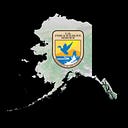National Wildlife Refuges
Fat Bear Diet Plan
Alaska bruins share their secrets for packing on the pounds
Are you a fan of the annual Fat Bear Week competition in Alaska? The popular single-elimination-style bracket asks people to weigh in on favorite furry contenders during their final preparation for winter.
Alaska’s bears have just six months to eat a year’s worth of food, so they must work hard over the summer and fall to get in supersized shape. In their winter torpor, a deep sleep similar to hibernation, they will not eat, drink, or release any bodily waste for several months. When they emerge from dens in the spring, they’ve lost little bone mass and muscle tone — a fascinating feat studied by NASA scientists and medical professionals.
How do they do it?
Torpor is a unique adaptation to survive periods when food is not easily available. Bears conserve energy by going into a deep sleep and reducing their body temperature by 8–12 degrees, slowing their heart rate and their breathing. They also begin to break down fat stores — the fat they spent months building up through a focused and intentional eating campaign.
- Bears enter a stage called hyperphagia as they prepare to den. During this time, they have an insatiable desire to eat and drink and focus most of their attention on obtaining food. The next several months of famine in the den will ultimately balance out the weight they gained in summer and fall.
- Coastal brown bears in Alaska grow larger than any other bears except for polar bears (which are marine mammals and have set records of around 2,000 pounds. The largest coastal brown bear may weigh in between 1400–1500 pounds).
- Adult male coastal brown bears may eat around 80–90 pounds of food and gain six pounds per day. Processing all that food takes time! Mid-day naps are also a critical part of the Fat Bear Diet Plan.
- Some of the largest brown bears in the world live in National Wildlife Refuges in coastal Alaska: Kodiak, Izembek, Alaska Peninsula, and Becharof. They reach epic proportions through an abundance of food, including energy-rich Pacific salmon.
As true omnivores, brown bears take advantage of seasonal abundance and time their servings with peak nutritional value and opportunity. Their final flab figure before denning may be hundreds of pounds more than their starting weight in early summer.
We share just a few of their stunning sustenance secrets below!
Tip 1: Eat your greens
Green plants like sedges, grasses, cow parsnip, and fireweed shoots are especially key in the early summer when bears have recently emerged from winter dens and other foods are scarce. Brown bears use their powerful shoulder muscles and long claws to dig for plant roots and bulbs. As salmon and berries come into season, plants still make up part of a bear’s daily meals.
Tip 2: Fish heads fish heads roly poly fish heads
Eat them up, yum!
Salmon are a not-so-secret ingredient to the massive size of coastal brown bears in Alaska. During the peak of salmon runs, an adult male brown bear in Kodiak National Wildlife Refuge may eat around 30 salmon a day! As their stomachs fill with fishy goodness, bears tend to high-grade their bites. Fish heads, skin, and eggs have a particularly high fat and protein content. Choosy chompers eat the best bits first and leave the rest to scavengers.
Tip 3: Always eat dessert
Alaska has a bounty of wild berries, and coastal brown bears collect them all: salmonberry, blueberry, and elderberry to name a few. A good way to know when berries have hit peak season? Piles of bear scat will be full of berry seeds!
Most berries are rich in sugars, a carbohydrate that helps bears with their weight gain goals when combined with their salmon protein buffet. Elderberries bring a unique superpower to the table: they have substantially more protein than most other berries and make a favorite bear treat. Plus the large clumps of berries on an elderberry shrub mean easier harvesting and less energy expended — win!
Tip 4: Feast from the sea
Bears that live along the coast benefit from a supplemental seafood surf and turf menu, scraping invertebrates from the rocky beaches, digging for clams in mudflats, and feasting on the occasional whale carcass washed ashore — the stinkier, the better.
Join us in cheering on Alaska’s bruins in their final seasonal preparations: may all the fat bears find their ideal weight to weather the winter ahead!
Contributed by Lisa Hupp.
In Alaska we are shared stewards of world renowned natural resources and our nation’s last true wild places. Our hope is that each generation has the opportunity to live with, live from, discover and enjoy the wildness of this awe-inspiring land and the people who love and depend on it.
